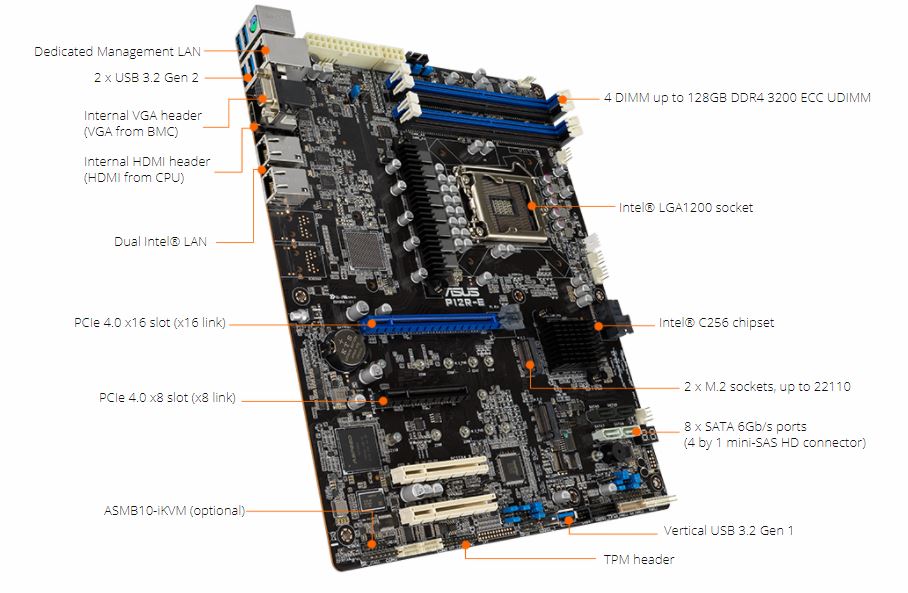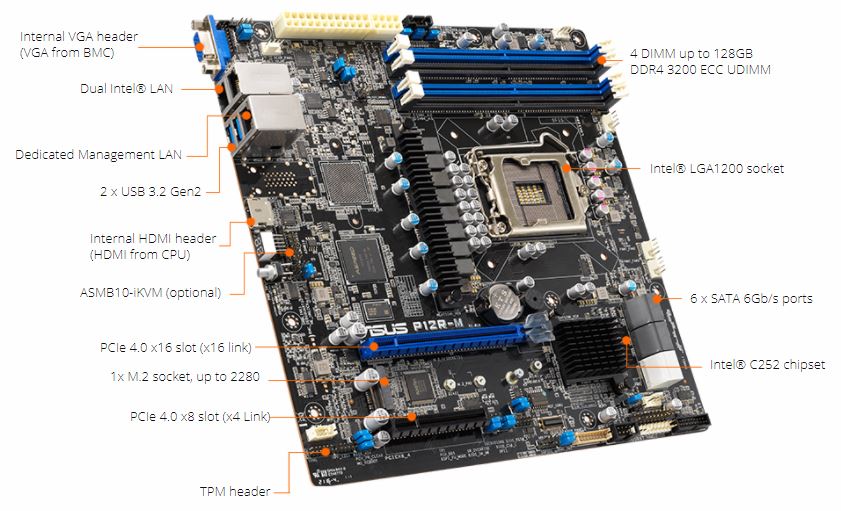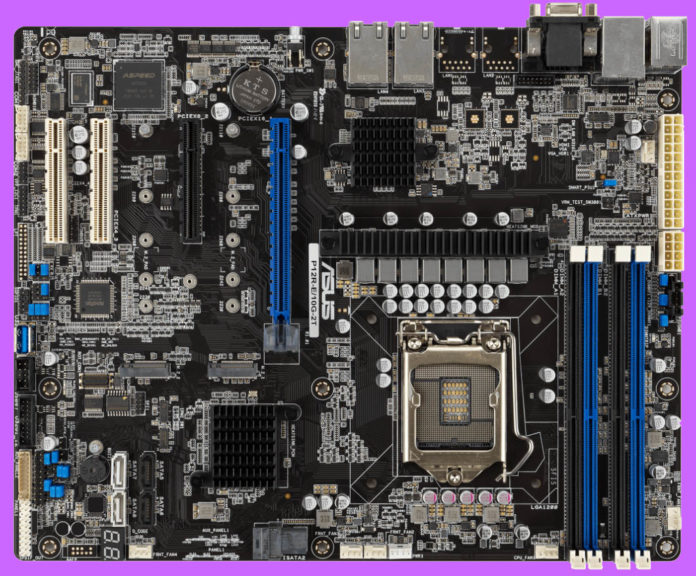Along with a new server platform (with redundant or single PSUs), we get four new ASUS Intel Xeon E-2300 series motherboards. ASUS is teasing a mITX fifth motherboard dubbed the ASUS P12R-I, but that is not being shown publicly at this point. Instead, we are going to cover the two ATX and two mATX motherboards ASUS is launching.
New ASUS Intel Xeon E-2300 Series Motherboards
We are going to cover these four motherboards in pairs. Effectively ASUS has an ATX and a mATX base platform and then has two variations on each platform. Across the platforms, ASUS is also touting its ASMB10-iKVM solution which is what we saw in our recent ASUS RS700-E10-RS12U 1U Intel Xeon Ice Lake Server Review.
ASUS Intel Xeon E-2300 Series ATX Motherboards
The higher-end of the two ATX motherboards is the ASUS P12R-E/10G-2T. This motherboard utilizes the higher-end Intel C256 PCH and has a full set of four DIMM slots. ASUS has a number of rear I/O features that are very interesting. These include dual 10Gbase-T via an Intel X710 NIC. ASUS also has two USB 3.2 Gen2 ports and even a VGA header from the CPU. One can use that in conjunction with a “G” suffix SKU and get a HDMI 1.4 output from this port.

The motherboard’s four PCIe slots, oriented like the picture above, are:
- PCIe x16 (Gen4 X16 Link), Auto switch to x8 link if slot 4 is occupied
- PCIe x8 (Gen4 X8 Link)
- PCIe x4 (Gen3 X4 Link)
- PCIe x4 (Gen3 X4 Link)
So the x4’s are coming from the PCH. In addition to all of these PCIe slots, we also get wo M.2 slots.
For those that do not want the capability and associated cost of the Intel X710 10Gbase-T networking, ASUS has another solution. The ASUS P12R-E has two Intel i210 1GbE NICs instead to lower costs.

Overall though, the ASUS P12R-E/10G-2T and P12R-E are very similar except for the NIC configuration. This helps drive volumes and helps mature firmware while lowering costs.
ASUS Intel Xeon E-2300 Series mATX Motherboards
The top-end mATX platform is the ASUS P12R-M/10G-2T. The base “P12R” may make one think that this is simply a mATX version of the P12R-E series, but that is not exactly the case. Although they are similar, the P12R-M/10G-2T uses the Intel C252 PCH. As such, we get two fewer SATA III ports (six total) and only one M.2 slot. With the 10G-2T, we know we are getting dual 10Gbase-T based on the Intel X710 chipset. With the mATX form factor, there is less space, so using the lower-cost chipset can make sense since components may not be easily placed.

As with the ATX motherboards, we get a 1GbE version, again with the Intel i210 called the ASUS P12R-M. It is good to see ASUS using the better supported Intel i210 instead of the PCH’s i219 MAC here for compatability.

One other item given up for the smaller form factor is that there is only one PCIe slot and that slot is limited to M.2 2280 (80mm.) There is a bit of a trade-off for the smaller form factor.
Final Words
The RS300-E11-RS4 and RS300-E11-PS4 1U servers seem to be based on the mATX platforms with the RS4 having redundant power supplies and the PS4 having a single power supply.
Something else that is really interesting with the ASUS offerings is that ASUS is highlighting that it has a FPGA for the Intel PFR feature. Intel’s current generation solution spanning up to the dual Ice Lake servers is to use a FPGA as the platform Root-of-Trust. For organizations that want this feature for Ice Lake system parity or just for this class of server, that may be a reason to look at the ASUS offerings since not all motherboards have this.
Overall, ASUS has some interesting server platforms but we are certainly intrigued by the P12R-I mITX solution coming.





I love the 10gbe network built in.
These are far more compelling than the SM Xeon E-2300 Series MBs. As already said due to the networking.
These look good. May be time to update my S2011v3 home server.
I noticed an Aspeed BMC in 1 picture, but I also saw a comment about the ASUS iKVM (optional).
Does that mean you buy the board then you buy a license or some sort of add-on to make the ASUS iKVM work?
I still like the Supermicro approach to KVM – it works right out of the box, immediately. You only need a license key if you plan to use KVM to update the BIOS remotely. I know in past articles that Patrick Kennedy has pointed out the value of the Supermicro KVM approach (it just works!) over that used by ASUS (pay up dude!).
Anyone have an idea when these boards will be commercially available?
I use an Asus P7F-E. It is old now. I’ve been looking at these boards ever since, in case I need to upgrade/repair. There has been the P8, P9, P10, P11, and now this P12. The P7F-E is still working for me very well with 8GB of RDIMM, PIKE-slot LSISAS1068E add-on, and the Asus MIO/PCIe-x1 slot ALC888 audio card. These add-ons were a good value/cheap.
To use the P12R-E, I cannot re-use the PIKE-slot card. Also, I do not see any MIO slot on the P12R-E, so I probably cannot re-use the ALC888 MIO card. I’d have to buy a new SAS HBA, like the PIKE II 3008-8i or some other similar HBA (maybe LSI SAS 9300) and some kind of a new audio card. This makes the P12 more expensive and more difficult than the P7F-E, which was sold an server/workstation board (not pure server).
The P12R-E BIOS has options for Intel HD-Audio [enable/disable]. Does this actually mean that the ALC888 MIO card could still be used in the bottom PCIe slot on the PCH? How do I use the HD-Audio feature in the BIOS? Well, too bad the P12R-E does not have the MIO slot (unless the bottom slot can take an MIO card).
The old P7F-E can take RDIMMs, but the new boards only take UDIMM. So, it is a step backwards. The P7F-E has been extremely reliable in 24/7 operation for 12 years and running. I would like to upgrade to the newest board in the P series someday, if the board has the features I am wanting. I also need 8 SATA for a raid6, plus an extra 4 would be nice for a DVD/Bluray and some spare disks.
I’ve looked at the ASUS WS C422 as an alternative. I’ll have to keep watching what new boards come out later, and probably skip everything for now.
About the Intel HDA audio support: I just needed to look further in the fine manual (which at 156 pages is better and more detailed than many other mainboard manauls)! In the P12R-E manual, appendix A-2 “P12R-E Series block diagram” shows the connection for ALC888PCH. Looks to me like my Asus ALC888 MIO audio card should work in one of the PCIe x8 slots on the PCH (slots 1 or 2). Probably the newer ALC892 would also work. So, the P12R-E might be a good upgrade from the P7F-E! The ALC888 is still a good little card, enough for my needs (it has coaxial S/PDIF that is getting hard to find, and I use it). The LSI SAS 9300 with this board still looks like a good choice also. I’ll have to keep considering this board, compared to the ASUS WS C422 (its manual is only 44 pages, so it seems harder to know all of its features for sure).